Side Menu:
Second Officer C.H.Lightoller -
From Shipwreck to Steam
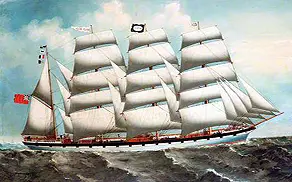
The Holt Hill - sister ship to the Primrose Hill
and wrecked on the island of St. Pauls.
(Click to enlarge)
Despite the difficulties of Lightoller's first voyage, life was not going to get any easier. In 1889, at 16 years old, Lightoller was moved to the Primrose Hill's sister ship, the Holt Hill. He writes:
“For some reason I changed over to the Holt Hill, sister ship to the Primrose Hill, and of the same Line. My cousin was Third Mate; I was then second voyage apprentice, and beginning to feel my feet. We were bound for Rio, and proud to sail under Captain "Jock" Sutherland, one of the greatest crackers-on out of Liverpool.”(47.)
The voyage firstly consisted of three misfortunes: losing a man overboard, a storm that almost capsized the ship, and an outbreak of smallpox, although fortunately Lightoller “seemed to be immune both from smallpox and yellow fever.”(47.)
But it was about to get even worse. They were on a voyage from Rio de Janeiro to Calcutta, under Captain George Sunderland and a crew of 32, when on November 13, 1889 the Holt Hill ran aground and was wrecked on St. Paul’s (now called Île Saint-Paul), a four-and-a-half-square-mile unpopulated island in the Indian Ocean. He describes the impact in his book:
“One could almost describe it as a relief from the racking suspense when at last she struck. With a shuddering crash she hit an outlying rock. The shock of that terribly alien feeling when a ship strikes the ground went through everyone like a knife. This was instantly followed by another terrific bump, then the sickening, rending crash, as she tore up the rocks, ripping the bottom right out of herself….I got a crack over the head with some piece of wreckage that came through the gutted saloon and State rooms. I had not earned the soubriquet of "Woodenhead" (through my ability to sleep soundly) for nothing."(47.)
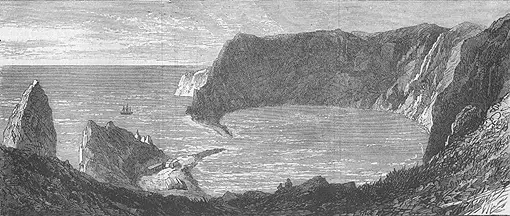
The Island Of St Paul, The Crater, an antique print, 1871,
where Lightoller was shipwrecked. (Click image to enlarge)
Ultimately, Chief Mate Williams was swept away to his death, but Lightoller survived along with the rest of the crew. They swam for their lives, barely making their way to the beach. In December 1889 the survivors were finally rescued by the crew of the Coorong and taken to Adelaide, Australia which they reached by Christmas 1889. Lightoller joined the crew of the clipper ship Duke of Abercorn for his return to England
Promotion
Undeterred by these events, in 1892 Lightoller returned to his first ship the Primrose Hill for his third voyage. They arrived in Calcutta, India, where he showed the beginnings of some aspiration when he passed his second mate's certificate on the 30th of May 1892, having now completed his four year apprencticeship. According to Bridge Duty - Officers of the RMS Titanic by Inger Sheil and Kerri Sundberg "most of Titanic's officers sat their examinations in British ports such as Liverpool, London or Hull. Lightoller, however, would take his Second Mate's examination in the port of Calcutta, India." Lightoller writes of the accomplishment:
“Officers were scarce in those days, so, with my chest thrown out like a man, and a real deep sea roll, I went on board a big four master bound for New York, as a fully fledged Second Mate. I will pass over the awful blunders I made before I gained any sort of confidence, and I also will not dwell on the perfectly poisonous time I experienced that passage.”(47.)
This qualification meant he could join his next ship, the Knight of St. Michael, a four-master owned by Greenshield, Cowe & Company, in the capacity of third mate in the year 1894. But this ship was not without drama either, when its cargo of coal caught fire, apparently caused by friction in the coal bins. The smouldering fire endangered both the ship and all aboard, forcing them to stop at the island of Bahia Blanca that involved getting his feet covered in prickles, bareback horse riding, hunting and killing a wild cat, and being jailed for murder because of carrying an officer's whistle.
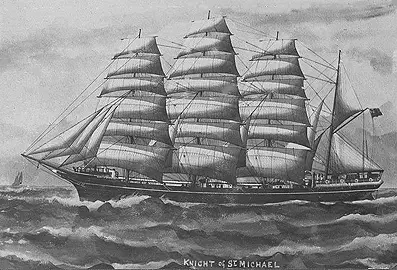
The Knight of St Michael aboard which Lightoller went from
third to second mate in 1894. (Click to enlarge)
After surviving such harrowing events it is perhaps not surprising that he was then promoted to second mate. Although according to his autobiography this “happened through the appointed second mate going on a terrific binge. He was an awfully good chap, and a splendid sailor, but a bit wet.”(47.)
On this voyage Lightoller also had several quite dramatic fishing experiences, from fishing with dynamite, to the time when he "caught what I firmly believe to be the first specimen ever known of a fish with hands and feet…it had tiny, but fully developed hands and feet.” He tried to preserve in whisky but it was eaten by crabs. Also on this voyage he sights the "biggest shark in the world….thirty-one feet, and he could have taken a full grown calf at a mouthful!”(47.)
However his time on sailing ships was coming to an end - and none too soon by his description:
“As it turned out, this was to be my last voyage in sail, and will always stand out as being the very worst. The passage out consisted of a series of gales topped off with a fire. Whilst on the homeward voyage we never had the skysails in once, except as a matter of form off the Horn; 165 days from Iquiqui to the Lizard (Cornwall). Six weeks in the Doldrums where it rained so incessantly that we had the oil completely washed off our oilskins."(47.)
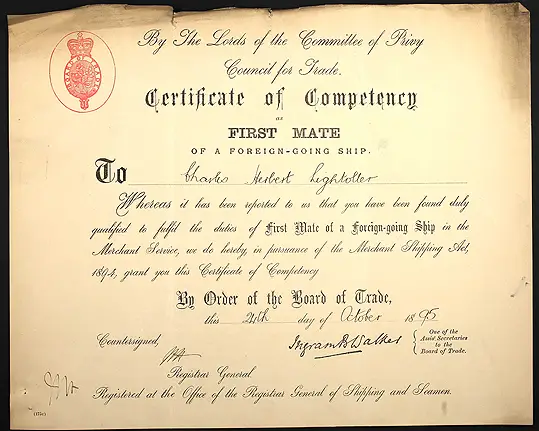
Lightoller's BOT certificate for First Mate, in 1895.
(Click image to enlarge)
Advantages and Disadvantages of Steam
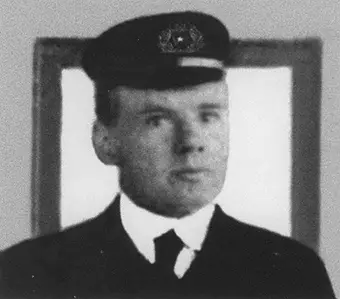
An undated image of a young Lightoller in uniform
(Click image to enlarge)
In 1895, at age 21, Lightoller obtained his first mate's ticket on the 21st October 1895. His first experience of steam was on a trip from New York to Glasgow, across the North Atlantic (or "Western Ocean" as he usually describes it) on a ship that rather curiously he did not name in his autobiography. According to Board of Trade records, however, his first steamship was the SS Memnon, a British cargo ship built in 1890, owned by Elder Dempster Lines. He signed on as third mate and worked aboard the ship from 31/5/95 - 4/7/95 (1 month, 4 days).
“I soon found myself third mate of a Western Ocean Packet, bound across the Pond. No more watching every vagary of the wind, no more luffing up to a squall and easing her away as she would bear it….All the driving done for one by the stokehold gang below. Just the steady plug and thud of the engines; into one sea, and through the next….We were bound for Glasgow, and that trip was my fist taste of “Steam.” Frankly, I didn’t like it. Good times, good food. Always sure of your watch below. Yet I loathed the smoke and the smell, and longed for the towering tiers of bellying canvas, the sound of water rushing past the scupper holes; in place of the monotonous clank and bang of machinery. I sadly missed the feel of something living under my feet.”
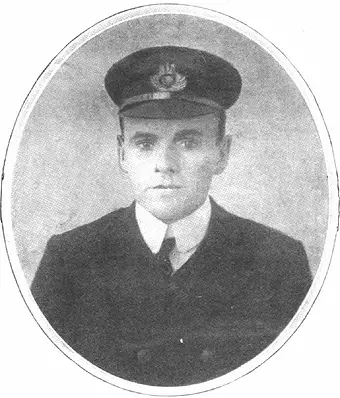
Perhaps the most famous portrait of Lightoller
aged around 20, circa 1894. (Click to enlarge)
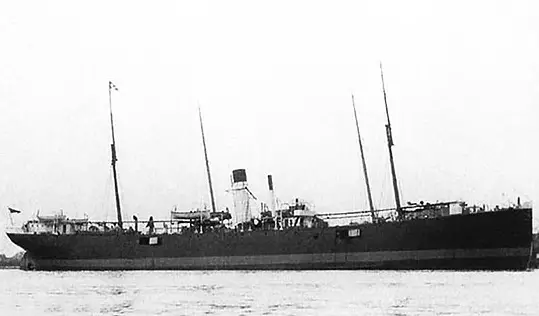
Lightoller's first steamship: SS Memnon, a British cargo ship built in 1890 owned by Elder Dempster Lines. Later, in 1917, the ship was torpedoed and sunk in the English Channel with a loss of 6 lives.